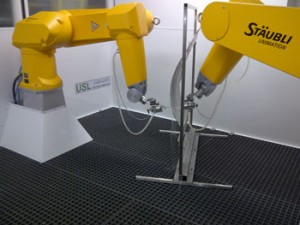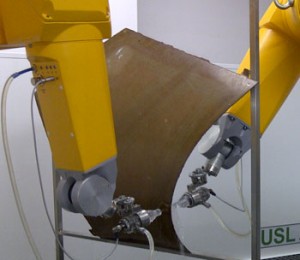Innovative approach to automating ultrasonic testing
 Ultrasonic Sciences Limited (USL) based in Aldershot, Hampshire, UK are leaders in the design and manufacture of automated and semi-automated ultrasonic testing systems. Many of their systems are in use around the world testing highly critical metallic and composite components mainly in the aerospace and metals industries. When USL decided to manufacture a fully automated robot based system Stäubli Robotics was selected as their development partner.
Ultrasonic Sciences Limited (USL) based in Aldershot, Hampshire, UK are leaders in the design and manufacture of automated and semi-automated ultrasonic testing systems. Many of their systems are in use around the world testing highly critical metallic and composite components mainly in the aerospace and metals industries. When USL decided to manufacture a fully automated robot based system Stäubli Robotics was selected as their development partner.
For over 25 years USL have been designing and manufacturing bespoke ultrasonic testing systems. Their highly advanced systems generate process and store data which is used to produce detailed 3D computer images and is retained for reference as the testing data record of each component, as required for all critical components in aerospace and many other sectors. Their systems employ a range of techniques ranging from immersion systems where the component is held underwater and the ultrasonic probe transmits ultrasound through the water into the submerged component to through transmission squirter systems where the sound travels through a jet of water to the component and a second head precisely located on the opposite side of the component section detects the transmitted signal. This technique is particularly useful for testing composite structures where delamination and defective bonding could arise.
USL are manufacturers of fully automated ultrasonic squirter systems, particularly for applications where complex shapes needed to be tested, such as aircraft fuselages and turbine blades. For these applications the ultrasonic heads needed to be fully synchronized, normal to the testing surface and capable of being positioned very accurately on either side of the component. Movement to the next required location had to be quick and precise with the system providing full data capture, typically recorded at a rate of 2000 readings per second with data being retrieved every 0.5mm. Defects being detected range from around 100µm on jet engine turbine blades to 6mm/12mm on aircraft composite parts. To provide these precise movement sequences USL decided that multi-axis robots would be an attractive alternative solution to their existing range of gantry systems. Robots were readily available; capable of being programmed to follow precise trajectories were reliable and easily maintained.
 Following a detailed review of the robot models and software available, USL selected Stäubli Robotics to provide the automation required. Stäubli six axis robots had the speed, accuracy of trajectory, precise movement; rigidity and reliability required and were reasonably waterproof. Most important of all was the Stäubli uniVAL driveinterface that could be used in association with the Stäubli controllers.
Following a detailed review of the robot models and software available, USL selected Stäubli Robotics to provide the automation required. Stäubli six axis robots had the speed, accuracy of trajectory, precise movement; rigidity and reliability required and were reasonably waterproof. Most important of all was the Stäubli uniVAL driveinterface that could be used in association with the Stäubli controllers.
Stäubli uniVAL drive is a totally new concept in robot system control having the flexibility and adaptability to synchronize any number of axes and any number of Stäubli robots in real time. This allowed USL to use their own programing systems and techniques to bring together into one control system not only the six axes from each robot but also the gantry movements as well as the ultrasonic squirter head, water pump and nozzle sequencing. Water flow needed to be adjusted to correspond to the contours of the test surface as well as compensating for the gravitational effects when operating at a higher level. Servos controlled both pumps and water jet angles. In total USL built a control system capable of handling up to 32 axes.
USL selected two Stäubli RX160 robots for the initial squirter ultrasonic testing system. This model provided the reach and rigidity required within a compact footprint capable of being floor mounted or suspended upside down. The robot design was inherently waterproof with all cabling being fed inside the arm; and protection levels of IP65 (IP67). Utilizing the flexibility of the uniVAL drive interface USL was able to control the complete system through their own bespoke controller.
Initial reaction to the new automated systems has been very good. Nigel Gray, Technical Director at USL commented, “Development of the fully automated ultrasonic squirter system has been easier than expected thanks to the operational adaptability of the Stäubli uniVAL drive and the intrinsic accuracy and robustness of the RX160 robots.”
Automated ultrasonic systems offer considerable benefits to users. Traditional testing procedures which typically, including loading and unloading, take several hours can be reduced to just a few minutes, with the added facility of full and secure data capture. One testing sequence normally taking 4 hours was reduced to just 14 minutes when a robot based inspection was introduced. Robotic systems are also easier to service and maintain significantly increasing availability.
The first applications of this new system will be installed in the USA for the testing of executive jet fuselages closely followed by the testing of other aerospace parts such as composite panels and jet engine turbine blades in the UK.
Visit the Stäubli Robotics website for more information.
See all stories for Stäubli Robotics















